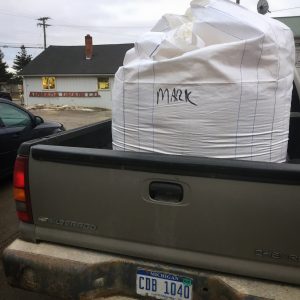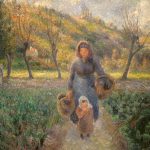Oakland Township, MI
My small, exurban farmstead is sustained, in part, by the relationship I forged with my local feed store. To help the reader appreciate the practical and economic benefits that this relationship has provided my fledgling farm, permit me to take you on a quick biographical and philosophical detour.
My “back to the land” story began years before my family moved onto ten acres of old field succession with an old house and barn on the fringes of the Detroit metropolitan area. I was inspired, like many Porchers, by the poetry and prose of Wendell Berry, which I read without ceasing while living in Uganda as a missionary with my wife and five children. In Uganda, I was immersed in a culture still shaped by localist and agrarian sensibilities and daily interacted with people whose livelihoods were rooted in the promises and perils of a land-based life. When my family repatriated to the States, we possessed fresh visions of a life governed by the soil and the seasons and relationships characterized by neighborliness and hospitality, tempered by enough realism to recognize our vision would require a lifetime commitment to a place on earth.
I came to see the work on my land largely as one of pattern-making
My agricultural principles were primarily shaped by Berry’s essay “Solving for Pattern,” which remains my go-to “how-to” for shaping the place I inhabit. His description of a good pattern sets the standard: “The farmer has put plants and animals into a relationship of mutual dependence … —the whole complex of problems whose proper solutions add up to health: the health of the soil, of plants and animals, of farm and farmer, of farm family and farm community, all involved in the same internested, interlocking pattern—or pattern of patterns.” Through Berry I came to see the work on my land largely as one of pattern-making: managing water, planting orchards, keeping bees, and constructing fences to weave pigs and chickens into an agricultural tapestry in a way that maximizes health and minimizes damage.
What does all of this have to do with a feed store? The aspiring urban/suburban farmer desiring to “solve for pattern” is confronted with two challenges in exchange for easier access to a market for his or her products: limited land and the absence of a “farm community.” I cannot scale production to produce feed on site. My neighbors are not farmers. A few of them, no doubt, lament that I am sacrificing their “privacy” by converting scrub forest into pasture. The “pattern of patterns” Berry describes in his essay and often illustrates in his fiction presupposes the availability of mutually dependent relationships that often intersected at grain elevators and feed stores where producers and consumers of products bought and sold knew each other by name. Aside from interested family and friends who encouraged our “hobby,” my farming community existed on social media and weekend visits to my “local” Tractor Supply chain store.
The first two years my family raised pigs provided a crash course in agricultural economics. We penned our pigs in mobile fencing to harness their natural rooting habits to clear invasive plants and root up stumps, an economic benefit in itself. But after selling pork shares to family and friends at a fair price and penciling in our costs (not to mention my time), it was clear the numbers weren’t working in our favor.
I shelved my how-to books and began consuming stories of contemporary small farms and noticed a pattern: flourishing farms were economically integrated with small local enterprises including repair shops, meat processors, and feed stores. I started calling around. I was surprised to discover how many feed stores and grain elevators dotted the landscape around me, but disappointed to learn that most simply sold pet food, softener salt, and ice melter. Except for a couple of holdouts. One, Armada Grain, had a livestock nutritionist on staff who eagerly walked me through protein ratios and trace minerals, even helping me figure out how to use minerals to supplement the unlimited supply of spent grains and the seasonal supply of apple pomace I can get freely from my local brewery and cider mills. Turns out he was just happy to talk to someone interested in getting into farming rather than getting out. I give most of my business to the smaller holdout, Washington Elevator, because of the convenience of calling a day ahead to have grain custom mixed into 80-pound bags that are often loaded onto my truck before I’m done paying and chatting about pasture forage (the Elevator has almost every grass seed under the mid-western sun and people that know how and when to plant them).
My feed store connections didn’t fix all of my problems, nor I theirs. Both holdouts are holding on by meeting the needs of modern consumers (one manufactures pet food, the other chemical fertilizers). Neither can tell me “whether the corn is GMO-free or not,” which can be a turn-off to my health-conscious customers. I know I can’t compete with grocery store prices because no amount of good feed will make my heritage breed pigs grow faster than their industrial cousins. But this feed store connection has become one of many essential parts of an increasingly complex pattern that makes my farmstead more than an idealistic vision, but a real possibility.





3 comments
Matt Miller
It’s good to see another Campbellite on the Porch! (I have degrees from York and Oklahoma Christian and have known folks at Rochester.)
I very much appreciate these stories of connections between new agricultural methods and old. We’ll need to build those ties if our agrarian projects are to come to fruition, I think.
Mark M
I could hear stories like yours anytime! And you are right about enjoying food produced on your own land – it can’t be monetized. A smokehouse is in my future.
David Naas
As one who went through college on the backs of Berkshires, your essay caught my eye. It was almost certainly easier raising pigs in rural Southern Illinois instead of Michigan (slightly milder winters, for example). And, to be sure, most of them went off to the auction, and did a fine job providing money to get me through four years of schooling (on a 2 1/2 acre plot, no less.) While the frustrations are manifest (slopping at 5AM in mid-January with a snow storm blinding you), the rewards (other than monetary) are tremendous. Daddy built a smokehouse, and every spring and fall, we would select one for butchering. There is nothing like fresh bacon sizzling in the skillet. (Or home-cured ham in a sandwich, with tomato and lettuce from our own garden. Sigh!)
Imagine my dismay, when, after school, I discovered what people paid at the grocery store for pork. No wonder it netted me pocket money like it did.
Comments are closed.